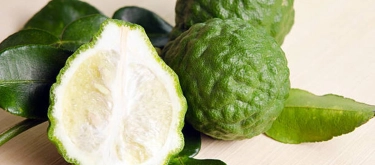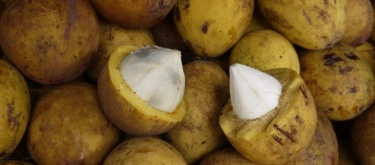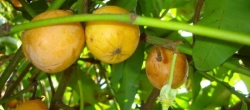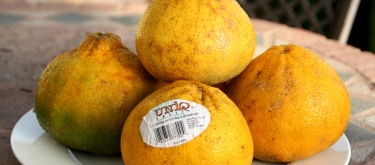Rangpur: Taste Profile, Aroma, Benefits and Health Risks
Rangpur (also known as Rangpur Lime, Mandarin Lime, Kona Lime; Citrus × limonia) is a unique citrus fruit believed to have originated in India or Bangladesh. Despite commonly being called a "lime," Rangpur is actually a hybrid between mandarin oranges and citron, known for its intensely sour flavor and mandarin-like aroma. Widely cultivated in South Asia, Brazil, and parts of the United States, Rangpur has gained popularity primarily as a flavor-enhancing ingredient in beverages, sauces, and preserves.
Rangpur is highly acidic, and excessive consumption may cause digestive discomfort or exacerbate conditions such as gastritis, acid reflux, or peptic ulcers. Individuals allergic to citrus fruits should avoid consumption. Pregnant women should consume in moderation due to its high acidity.
What does Rangpur taste like?

Complete Sensory Description:
Taste
Rangpur possesses an intensely tart, acidic profile, significantly more sour than conventional limes or lemons, coupled with subtly sweet mandarin-like undertones and faint bitter notes from its aromatic zest.
Aroma
The aroma of Rangpur is bright, citrusy, and refreshing, featuring distinct mandarin-like fragrances combined with subtle floral and herbal notes, notably reminiscent of orange blossoms and lemongrass.
Texture
The fruit’s outer rind is thin, glossy, and aromatic, while the pulp is juicy, segmented, and packed with numerous small seeds. The juice is abundant, watery, and refreshing, with a texture similar to lime juice.
Appearance
Rangpur fruits are typically small, rounded, and slightly flattened at the poles, measuring about 3–6 cm in diameter. Their skin color ranges from deep orange to reddish-orange when fully ripe, resembling small mandarins or tangerines. Internally, the fruit has bright orange pulp with multiple seeds.
In-depth Flavor Analysis:
Rangpur’s intense flavor profile is derived from its chemical composition, characterized by elevated concentrations of organic acids, sugars, and aromatic volatile compounds:
-
Acidic Profile: Rangpur exhibits remarkably high citric acid levels, far exceeding typical limes or lemons. This high acidity dominates the taste experience, imparting its characteristic sharp, mouth-puckering sourness.
-
Sweetness and Bitterness: A moderate presence of sugars (primarily sucrose and fructose) provides slight sweetness, subtly tempering acidity. The presence of bitter compounds, primarily limonoids and flavonoids concentrated in the rind, adds complexity and depth to its overall flavor profile.
-
Aromatic Compounds: The fruit’s appealing mandarin-like aroma is attributed to essential oils rich in limonene, myrcene, and linalool. Limonene provides bright citrus notes, myrcene contributes herbaceous depth, while linalool adds delicate floral dimensions. Additionally, volatile aldehydes such as citral enhance freshness and complexity.
-
Environmental Impact: Flavor intensity and acidity vary significantly according to climate and soil conditions, with fruits grown in warmer regions typically developing stronger aromatic properties and slightly balanced acidity.
Varieties and Culinary Applications:
Although Rangpur is a hybrid itself, no distinct commercial varieties are widely recognized. Its culinary applications, however, are diverse due to its intense flavor:
- Beverages: Widely used as a primary ingredient in cocktails, notably in gin-based drinks or Brazilian caipirinhas.
- Condiments: Ideal for marinades, dressings, sauces, and chutneys, offering intense acidity balanced by citrusy aromatics.
- Preserves: Often utilized in marmalades, jams, pickles, and fruit curds.
- Culinary Flavoring: Frequently added to seafood dishes, grilled meats, and Southeast Asian curries as a souring agent and aromatic enhancer.
Selection and Storage:
Select Rangpur fruits with firm, smooth skin and vibrant reddish-orange or deep-orange coloration, indicating optimal ripeness. Avoid overly soft, bruised, or shriveled fruits. Store fresh Rangpur at room temperature for short-term use or refrigerate for up to two weeks. Juice can be frozen for long-term preservation, maintaining flavor effectively.

Nutritional Insights:
Rangpur is notably rich in vitamin C, antioxidants (including flavonoids), potassium, calcium, and dietary fiber. Regular consumption of Rangpur or its juice can significantly support immune function, help combat vitamin C deficiencies, and improve iron absorption from plant-based diets. Its high antioxidant content provides cardiovascular protection and helps mitigate oxidative stress, potentially beneficial for individuals prone to chronic inflammation or immune deficiencies.
Expert Insights & Culinary Tips:
- Flavor Pairings: Rangpur’s intense acidity is an excellent counterbalance in rich or fatty dishes, complementing seafood, poultry, coconut-based curries, and avocado-based salads.
- Preparation Recommendations: Due to high acidity, chefs recommend balancing Rangpur juice with sweeteners (honey, sugar) or aromatic herbs (mint, basil) to achieve harmonious flavors in beverages and sauces.
- Seed Management: Remove seeds when using fresh segments, as their bitterness can overpower culinary preparations.
Interesting and Curious Facts:
- Despite commonly being called "lime," Rangpur’s genetics and appearance place it closer to mandarins and citrons, creating confusion in botanical classification.
- In Brazilian cuisine, Rangpur juice (known as "limão cravo") is an essential ingredient in the iconic cocktail "caipirinha," valued for its distinctively sour flavor.
- Historically cultivated as an ornamental citrus in Europe and America due to its decorative fruits and aromatic blossoms.
Harm and Dietary Considerations:
Excessive consumption of Rangpur fruit or juice can irritate the digestive system, worsening symptoms in individuals suffering from gastritis, acid reflux, or ulcers. Individuals allergic or sensitive to citrus fruits must avoid Rangpur entirely. Moderate consumption during pregnancy is advisable due to high acidity.
Religious Dietary Considerations:
Rangpur is universally acceptable within all major religious dietary guidelines, including Halal, Kosher, Hindu vegetarianism, and Buddhist dietary practices. It has no known religious restrictions or associations.
Final Thoughts & Sensory Journey:
Rangpur offers a vibrant sensory journey defined by intense acidity, aromatic mandarin fragrance, and sophisticated bitter-sweet complexity. Its versatile culinary applications, nutritional value, and exotic flavor profile solidify its unique place among citrus fruits, inviting experimentation and culinary creativity.
Resources:
- "The Citrus Industry" by Walter Reuther, Herbert J. Webber, and Leon D. Batchelor (University of California Press, 1989)
- "Citrus Fruit: Biology, Technology and Evaluation" edited by Milind Ladaniya (Academic Press, 2008)
- "Tropical and Subtropical Fruits: Postharvest Physiology, Processing and Packaging" by Muhammad Siddiq (Wiley-Blackwell, 2012)











